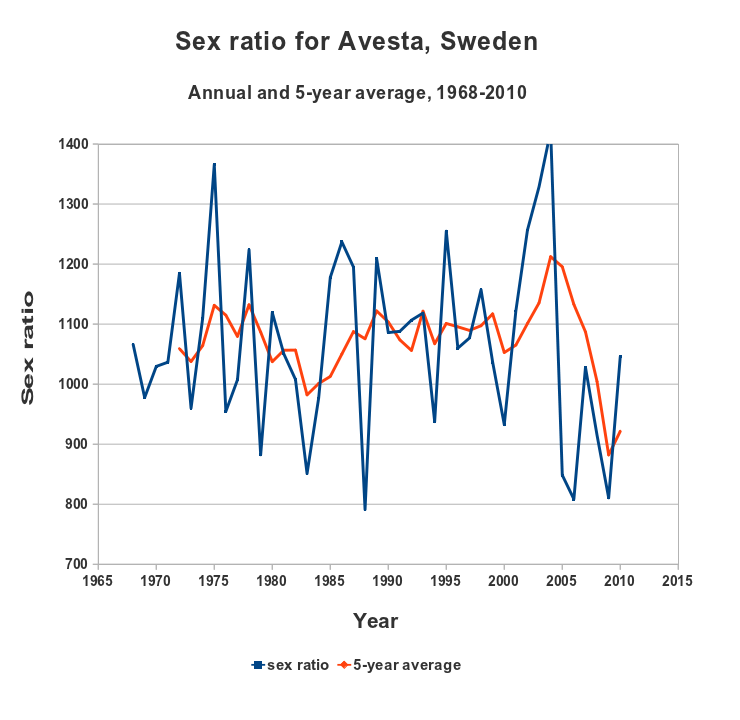This video explains it all in a very concise and clear manner, not much more needs to be said really …..
Category: Chris Busby
The alarmist and self-proclaimed radiation expert Chris Busby is portrayed by some people as a hero, and some of the comments/insults that several NPYP members have received after our scrutinies, or when referring to them in discussions on other blogs, clearly show that he still has his devotees.
But does Chris Busby really believe in Chris Busby? This is far from certain. He certainly displays a number of pseudoscientific traits, but how much of a nut is he really? He has surely figured out that he can make a living from scaring people about the health effects from radioactivity (not all attempts succeed), and some of his behaviour clearly shows that he is more keen on protecting the trademark Chris Busby™ than on making sure that he is correct in his statements. To admit errors does not seem to be on the agenda, and the dull road of sticking to the truth appears to be of little importance, in spite of all his philosophical litanias about ethics in research and the dishonesty of others.
4 CommentsA powerpoint presentation made by professor Majia Holmer Nadesan is getting some attention around the web, in the presentation she claims that the Japanese authorities, among others, lied and covered up information about the Fukushima accident. So let’s have a look at it.
68 CommentsBy Kazue Avril – Free Press
It has been a busy day here at the NPYP center, where the members of Nuclear Power Yes Please held a press conference. They recently discovered a devastating text by Professor Chris Busby, where he shows that their criticism of his research is completely unfounded. The NPYP Scientific Director Mattias Lantz had attacked Professor Busby’s articles about Fallujah (here, here, and here), by making a comparison of the sex-ratio (i.e. the number of boys born vs number of girls born) between the Iraqi city of Fallujah and his own city of birth, Avesta in Sweden. According to Lantz the variations in Avesta were as large, or larger, than the ones in Fallujah, so he reasoned that one could not claim that the variations in Fallujah were due to depleted uranium (DU). Professor Busby turned the data from Avesta around, and showed that Lantz had used the data in a dishonest way, even trying to hide an obvious correlation between increased sex-ratio in Avesta and the 2003 war in Iraq. Professor Busby’s eminent rebuttal can be found on the LLRC web site (here). Below is the figure made by Lantz, with Professor Busby’s hand-written notes that give evidence of the dishonesty of Lantz.
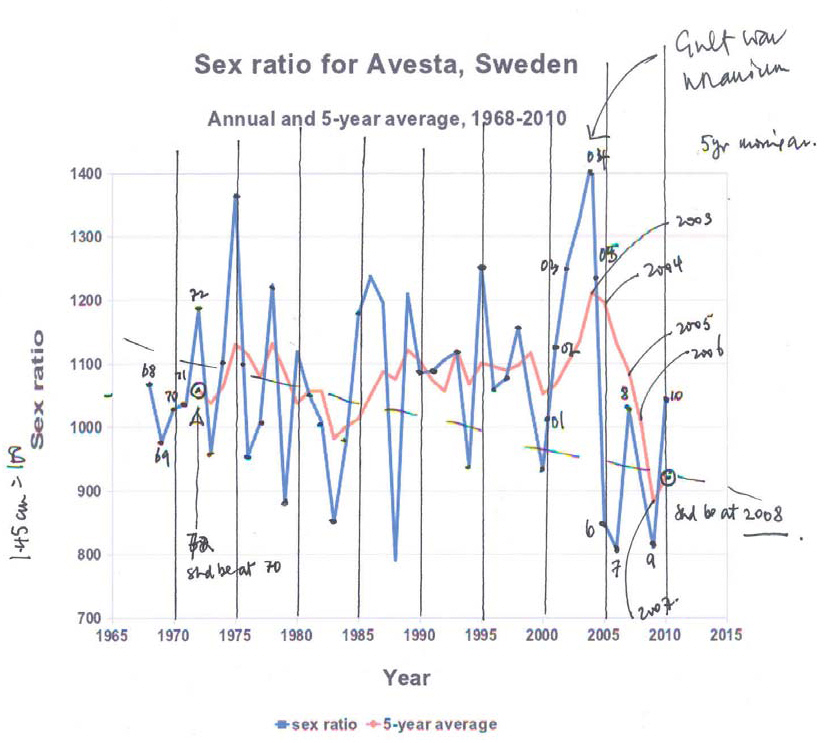
– ”I never even thought of the correlation,” a humiliated Mattias Lantz said at the press conference, ”but Professor Busby clearly shows that the deviating sex-ratio in Avesta around 2004 is due to the DU-weapons used in Iraq. Furthermore,” Lantz continued, ”this means that all of our past criticism of Professor Busby falls apart, just like a house built from a deck of cards. I now realize what an omnipotent genius he is. He is right about everything, even when he cheats with statistics.”
– ”And he is a great musician!” Gender Issues Director Nils Rudqvist adds.
– What does this mean for the future of NPYP?
– ”This changes everything.” says Policy Director and NPYP founder Michael Karnerfors, ”We have been wrong about all these issues; about radiation effects, nuclear power, cell phone radiation, chem-trails, dowsing, crystal healing and the HAARP experiment. Therefore, we will now turn sides in the debate on all these issues, and we will join Professor Busby, Mona Nilsson, Lennart Hardell and all the other serious researchers in their noble quests. From now on, scrutinizing alarmist claims, checking statistics, or asking the simple question ‘Is this relevant?’ has no place in what we consider to be a serious debate. Google was created to find the scary claims, not to scrutinize them. Many people are scared about radiation. From now on we will help them to maintain that status.”
– What about your close ties to the nuclear industry?
– ”We will pay back every penny of the funding we got from those bastards,” says Financial Director Christoffer Willenfort, ”and those of us who are employed by the nuclear industry will submit letters of resignation today, we are all done with it.”
– And the organization?
– ”The first reaction was of course that we should dismantle NPYP and join other groups, but after some intense brain storming we decided that it is better to continue, although under a different name.”
– ”Yes, from today we are Nuclear Power No Please,” confirms the Public Relations Director Johan Kreuger, ”and here is the new logotype!”
An embarrassing silence grew in the press room, until somebody in the audience dared pointing out an obvious error in the spelling.

– ”C’mon people, give us a break!” Kreuger burst out. ”We have been wrong about so many things for years, so how can you expect us to get every tiny detail right immediately?”
– What is Lantz’ status within the organization, can he continue to be a member?
– ”Well,” says Karnerfors, ”at first we thought that he had to go. We were all very disappointed with him and felt that we needed to distance ourselves from him and the dishonesty that he brought upon us. But we are all to blame. It was certainly Lantz who would initiate the studies of Professor Busby’s claims, but we all started to act like stupid physicists and make independent double checks of numbers and other details. That was of course foolish of us, we should have trusted Professor Busby from the beginning without asking any questions.”
– So you now believe in Professor Busby’s claims?
– ”How can you not, after what we have been through?” Reactor Technology Director Johan Simu says. ”Professor Busby has an expertise in so many scientific fields, not only in radiation effects. A few months ago he introduced a new definition of the term ‘spontaneous fission’, and with it he showed that TEPCO is lying about the status of the reactors in Fukushima. With the new definition, the reactors must clearly be active in a critical configuration. My personal reflection at the time was that this is utter nonsense. But now, after Professor Busby’s proof of our dishonesty, I am all for it. The effects will be tremendous; all courses in reactor physics will have to be revised, and the commercial codes used today for criticality calculations have to be changed. But that is not all, recently he also showed that Einstein is wrong.”
– What?
– ”Yes indeed, Professor Busby’s interpretation of the twin paradox is quite convincing. He has also promised to explain quantum mechanics on Youtube, something that we are all looking forward to. It is about time that somebody settles the issue whether that cat of Schrödinger is alive or not, the world deserves to know. Furthermore, this poor creature has been in this un-collapsed wave function state for so long, it is clearly a violation of animals rights that needs to be brought to an international court. Professor Busby’s expertise also in legal matters will be very helpful in order to bring the perpetrators to justice.”
On the way out from the press room we manage to get hold of Mattias Lantz for a personal comment, he looks tired and stressed out.

– Will you apologize to Professor Busby and the other people that you have attacked over the years?
– ”No, of course not!” Lantz responds rather agressively. ”Earlier we would have done such a thing, or corrected our statements if they were found to be in error. Now when we have changed sides in the debate we will follow the established customs of our new friends. Apologies or amends are out of the question. Instead we move on forward, though in the opposite direction as before.”
– How did you react when it became clear that you had been so wrong about Professor Busby?
– ”I felt awful, of course. Not so much for my unfounded attacks on Professor Busby, but on a personal level it is devastating. In the plot that Professor Busby turned against me there is also a peak with high sex-ratio in Avesta during the 1970’s when I was born. This puts the question about my gender at stake, maybe I was supposed to be a girl? This will take years of psycho-therapy to sort out.”
Then he excuses himself and pushes through the crowd towards the entrance, stopping every now and then, asking people if they know where he can get hold of a good beret.
We get a private interview with Industry Liaison Director Johan Kihlberg.
– ”Former Industry Liaison Director, if I may! The title does not exist any more now that we have severed the ties with the nuclear industry.”
– So, what is your title?
– ”Alarmist Organizations Liaison Director.”
– Ok, ok, so how was the error of Lantz discovered?
– ”We knew for a while that something was not right. Lantz has of course always been obsessed with Professor Busby. Certainly the money from industry and Socialstyrelsen kept him motivated, but there was also something else, some sort of…envy. And during the last few months he has become more and more deranged. You could find him at late hours in his office, but he would not deliver any new blog posts or forum entries. If you met him in the corridor you could hear him mumbling weird things for himself.”
– Weird things?
– ”Yes, phrases like ’eminent scientists’, ‘Bramhall is not a pushover’, ‘ICRP doesn’t get it’, or ‘there must be a third event’ were often repeated. Things like that. Then, a few days ago in the coffee room he made no sense at all, trying to convince us that ‘the alarmists get laid more often than we do’ and that we should buy a boat, or two. Last Friday we discovered that he had asked the market analysis division for an evaluation about entering the field of anti-radiation pills, and there were follow up plans for major investments in this field. When this was found out we decided to check his computer. It turned out that for the last month he had used the computer for only one thing, to visit the ‘Dishonesty’ page on the LLRC web site, over and over again.”
– So what did you do?
– ”It was the first time that any of us saw that web page, and after reading it we realized that it was all over. A crisis meeting was held, thereafter we summoned Lantz in order to have him explain himself. There was an intense discussion, with harsh words being exchanged in all directions, but finally we could agree on a strategy and decided to call for the press conference.”
– These plans that Lantz had initiated for anti-radiation pills, how far had he gone with them?
– ”Actually, very far,” Kihlberg responds with some excitement.
– So how did you stop it?
– ”We didn’t. The analysis shows that we can make a huge profit even if we sell the pills at half the price compared to what Busby and his friends had in mind. We have some connections in Japan that will help us with the promotion, there are many ways to scare people into becoming your customers. For instance the Japanese TV-channel NHK has been very helpful by making an alarmist documentary in which the credibility of ICRP is undermined. We are also considering to buy the recently closed candy factory in Gävle. In that way we can have a local production directly in the areas that were most affected by the Tondel study.”
– You mean the areas that were most affected by the Chernobyl fallout?
– “No, by the Tondel study.”
– Ah, whatever. So you will manufacture and sell pills in order to raise money for the suffering children?
– ”What do you mean? We have to make up for the losses now that we have stopped the funding from the nuclear industry. We are the good guys now, we need to make a living. Just look at Green Audit, the Cancer and Birth Defects Organization, and so on. They are registered as companies, not as charities, why should we be any different? Why live on secret funding from evil companies when we can make as much money in the open by exploiting the gullible, the naive, and the vulnerable? To have funding from the industry in order to change people’s opinion is a difficult task, it is much easier to get money directly from concerned citizens in order to help them preserve their already established views. Busby is of course a huge inspiration in these matters, but we are also looking at other options.”
– What kind of options?
– ”For instance, Joseph Mangano and his Radiation and Public Health Project is a good example. They have managed to recruit celebrities like Alec Baldwin and Christie Brinkley for the fundraising. And they are very successful, just look at the suits of Mangano! So we hope to be able to do something similar from a Swedish perspective, if we can get stars like Manne the Clown and Solveig Ternström on our team, then we are all set.”
– So the future is bright…?
– ”Yes, brighter than ever. This has been a severe crisis situation for us, but thanks to Professor Busby we are finally on the right track. An event like this does not happen every day, but today it did indeed happen.”
22 Comments
Vi noterar i dagarna en artikel som publicerades den 21 November i den brittiska tidningen The Guardian, där Chris Busbys pillerförsäljning uppmärksammas. I artikeln, skriven av George Monbiot och Justin McCurry, redovisas de organisationer och websiter kring Busby som på sistone börjat sälja piller med mineraler som sägs rensa ut radioaktiva ämnen ur kroppen. Ett antal forskare inom olika ämnesområden avfärdar metoden och Busbys uttalanden som grundlösa och absurda.
Det hela började efter att Chris Busby i september lagt upp ett filmklipp på Youtube (här är filmen, och här är vår nedskrivna text av vad han säger) där han pratar om piller som de skall distribuera till självkostnadspris åt barnen i Fukushima. Artikeln i The Guardian visar tydligt att man säljer dessa piller till ockerpriser, tvärtemot vad Busby hävdar. Notervärt är även att vissa av websiternas länkar för donationer leder till ett konto i Wales kopplat till Busbys organisation Green Audit.
Chris Busby har tidigare varit vetenskaplig rådgivare åt det brittiska Green Party. Men nu tycks partiet äntligen ha insett att han går för långt, och distanserar sig från honom och hans senaste uttalanden.
Vi välkomnar detta uppvaknande och hoppas att de svenska organisationer och politiker som brukar frottera sig med Busby nu tänker om. Den bristfälliga forskning och de alarmistiska uttalanden han gör inom diverse olika ämnesområden har inte mycket med verkligheten att göra, och de som fortsätter hänvisa till hans studier undergräver sitt eget förtroendekapital.
En av artikelförfattarna, George Monbiot, har idag (22 november 2011) lagt upp lite mer information om Chris Busby på sin blogg (här).
/Nuclear Power Yes Please
Länkar:
- 21 November 2011: Artikeln i The Guardian
- 22 November 2011: George Monbiots blogginlägg (varning för fula ord)
- 19 September 2011: Busbys Youtube-klipp om piller och konspirationer
- -> Vår nedskrivning i text av vad han säger i Youtube-klippet
- The Christopher Busby Foundation for the Children of Fukushima (på japanska)
- CBFCF-sidan där man kan donera pengar till Green Audits konto (på japanska)
- 4u-detox.com (på japanska)
- http://busby.harmonicslife.net/ (på japanska)
- 21 april 2011: Mark Lynas blogginlägg om Chris Busby och Green Party
Länkar till våra tidigare blogg- och foruminlägg om Chris Busby
- 15 augusti 2010: Rapport från ett anti-kärnkraftmöte i Stockholm 10 augusti 2010
- -> Engelsk version av rapporten från BSRRW-mötet 10 augusti 2010, fokus på delen med Busby
- -> Nedskriven text av vad som sägs under Busbys presentation om Fallujah, BSRRW-mötet 10 augusti 2010
- 7 februari 2011: Chris Busby i farten igen, om påstått läckage av uran från kärnkraftverket i Hinkley Point
- -> Engelsk version om Busby och Hinkley Point
- -> Leak of uranium from the Hinkley Point nuclear plant? (längre version i vårt forum om Busby och Hinkley Point)
- 21 oktober 2011: Chris Busby – Scary Rider (Granskning av BSRRWs JK-anmälan av Socialstyrelsen)
- 11 november 2011: Chris Busby and the Fallujah sex ratio – part 1 (dishonesty)
- 14 november 2011: Chris Busby and the Fallujah sex ratio -part 2 (incompetence)
- 18 november 2011: Vår granskning av Busbys två studier om Fallujah
- 18 november 2011: Öppet brev till LO, ABF, ARK, Iraksolidaritet, FiB/Kulturfront och Socialistiska läkare angående Busbys seminarium på Socialistiskt Forum 19 november 2011
Öppet brev till arrangörerna av Socialistiskt Forum (LO och ABF) och seminariet i ABF-huset, Ängbyrummet, lördag 19 november 2010, kl. 16.00-17.00 (Iraksolidaritet, ARK, FiB/Kulturfront och Socialistiska läkare).
På lördagens Socialistiskt Forum i ABF-huset hålls ett seminarium med titeln “Missbildade barn i Irak – ett krigsbrott”. Vi noterar med förvåning att huvudtalaren är Chris Busby, självutnämnd strålningsexpert med tveksam kvalitet på den forskning han hävdar sig vara expert på.
På sistone har han gjort märkliga uttalanden om strålningsriskerna kring Fukushima, och han uppmanar lokalbefolkningen att ta piller med olika kemikalier i syfte att rena kroppen från radioaktiva ämnen. I samband med detta har flera företag börjat sälja diverse medel i Chris Busbys namn (mer information och diverse avslöjande länkar finns på den japanska websidan Chris Busby Foundation for the Children of Fukushima: http://www.cbfcf.org/).
- Till att börja med finns det inte några vetenskapliga belägg för att dessa metoder fungerar, och i vissa fall kan eventuell överdosering vara skadlig. Busby hänvisar till hur man använder jodtabletter i förebyggande syfte vid radioaktiva utsläpp, men det är nu frågan om andra ämnen som fungerar annorlunda i kroppen. Dessutom är det, milt sagt, tveksamt om de alls har någon effekt i efterhand (detsamma gäller för jodtabletter).
- Till detta kommer frågan huruvida Busby gör detta av egenintresse eller inte. Han hävdar att han inte har någon ekonomisk vinning från detta, men flera websiter där pillren säljs har länkar med information om ett bankkonto i Wales som är kopplat till honom och hans organisation Green Audit. Dessutom säljs dessa piller för mångdubbla priser mot vad man får betala i en hälsokostaffär. Det är alltså rent kvacksalveri som Chris Busby sysslar med.
Lördagens seminarium kommer dock handla om de rapporterade hälsoproblemen i den krigshärjade staden Fallujah i Irak. Vi är lika bestörta som alla andra över uppgifterna om drastiska ökningar cancer och andelen barn som föds med missbildningar, och är måna om att orsakerna utreds och att de drabbade får den hjälp de behöver.
Därför har vi granskat det två artiklarna om Fallujah som Chris Busby ligger bakom och finner ett antal allvarliga felaktigheter, överdrifter, tveksamma tolkningar och direkt fusk. Några exempel (utförligare förklaringar ges på länkarna längst ned):
- I augusti 2010 var Busby i Stockholm och pratade om sin första Fallujah-artikel. Han lade då mycket tid att förklara den så kallade könskvoten, då man funnit att andelen pojkar bland barn under 5 år var ovanligt låg. Redan då påtalades ett allvarligt fel i metodiken vilket gör att man inte kan dra de slutsatser som Busby gör. Trots att detta påtalats så fortsätter Busby att hänvisa till resultatet som ett av de viktigaste i artikeln. Vidare har vi funnit mer drastiska variationer i könskvoten i ett flertal svenska städer, och det är svårt att tro att Busbys förklaringsmodell skulle gälla även där.
- Busby hävdar att deras mätningar på hår antyder att vapen med låganrikat uran skall ha används av USA i Fallujah. Från den information som ges i artikeln finns inga tecken på att det uran man uppmäter avviker från den naturliga blandningen, och mätosäkerheterna redovisas inte. Trots detta ägnar sig Busby och medförfattarna åt långt gående spekulationer om vilken slags vapen som använts, Busby har vid flera tillfällen även påstått att vapen baserat på kall fusion skall ha använts. Det borde vara svårt att ta honom på allvar efter detta.
- De halter av uran som uppmätts kan tyckas höga, men är inte högre än de variationer man kan hitta i hår hos människor i Sverige. Att från dessa uranhalter i hår hos föräldrarna hävda att barnens hälsoproblem orsakats av uran kräver en bevisföring som Chris Busby visat sig inte förmå.
- I den studie som Busby och medarbetare gjort har man alltså mätt uranhalt i hår till föräldrar vars barn har någon form av hälsoeffekt. Men man har ingen kontrollgrupp med uranhalter i hår till föräldrar vars barn är friska. Detta är en allvarlig brist som reducerar övriga förklaringsmodeller till rena spekulationer. Att Busby framhärdar med en enda teori (radioaktivitet från uran ger upphov till hälsoeffekterna) utan att ens nämna alternativa förklaringar är ett tydligt tecken på pseudovetenskap.
- På flera ställen hänvisar Busby till andra artiklar som sägs stödja hans resonemang. Vid läsning av dessa artiklar finner vi flera gånger att slutsatserna i dessa är direkt motsatta det som Busby hävdar. Vi hittar också exempel där Busby har förvanskat resultaten i de refererade artiklarna för att få sitt eget resonemang att verka mer övertygande. I några fall hänvisar han till artiklar som han själv skrivit och publicerat i en påhittad tidsskrift som inte finns, det går alltså inte att få tag på artiklarna och verifiera Busbys påståenden.
Med allt detta sammantaget ställer vi frågan till arrangörerna av seminariet; Iraksolidaritet, ARK, FiB/K och Socialistiska läkare: Tror ni verkligen att ni kommer att lära er något om situationen i Fallujah genom att bjuda in Chris Busby? Borde ni inte kunna finna mer seriösa forskare i denna angelägna fråga?
Vidare ställer vi frågan till huvudarrangörerna LO och ABF:
Står ni bakom att man bjuder in en kvacksalvare till Socialistiskt Forum?
För oss är svaret dessvärre uppenbart. Den enda som kommer tjäna något på morgondagens seminarium är Chris Busby själv, det blir ytterligare en fjäder i hatten för honom. För alla människor som är engagerade i de olika frågorna i Irak och Fallujah blir detta ett slöseri med deras tid, engagemang och pengar. Och trovärdigheten för de arrangerande organisationerna, inklusive LO och ABF, naggas i kanten.
Nedan finns länkar till de blogginlägg där vi har granskat, och fortsätter att granska, Busbys artiklar om Fallujah:
- http://nuclearpoweryesplease.org/blog/bad-science-chris-busby-and-his-articles-on-fallujah/
- http://nuclearpoweryesplease.org/blog/2011/11/11/chris-busby-and-the-fallujah-sex-ratio-part-1-dishonesty/
- http://nuclearpoweryesplease.org/blog/2011/11/14/chris-busby-and-the-fallujah-sex-ratio-part-2-incompetence/
För det oberoende nätverket Nuclear Power Yes Please:
Mattias Lantz, Uppsala
Johan Kreuger, Uppsala
Nils Rudqvist, Göteborg
Michael Karnerfors, Lund
Liisa Petrykowska, Accra
Johan Kihlberg, Linköping
6 Comments
In the previous post, it was noted that Busby’s claims about a deviating sex ratio in Fallujah (first article here, second article here) may not be such a significant finding as he makes it sound, and that Busby is well aware of it but doesn’t change his approach about it. There are weaknesses in the study, both methodological and due to the difficult circumstances in performing the study. So, in lack of other data, the results of the study may be of interest, and if properly designed the survey may give much better results than other kinds of surveys. But with the weaknesses in mind it would be reasonable expect a more humble approach from Busby and co-authors about the conclusions, if they are serious about it, that is.
One of Busby’s most significant findings, according to himself, is the deviating sex ratio for the children born in the years after 2004, the year of the battle of Fallujah. The first study shows a decrease in the number of boys with respect to the number of girls, 18% below the normal level (860 boys to 1000 girls instead of the expected 1055 boys to 1000 girls). According to Busby this must be due to mutagenic stress induced by radioactivity from uranium. To support this theory he cites studies about lower sex ratios when the parents have been exposed to uranium in mines, medical radition treatment, and the Hiroshima bomb. So if we ignore the weaknesses of the study, we may agree with Busby that an 18% reduction in the number of boys born is interesting.
The problem is that he consistently ignores all other possibilities. The wikipedia page on human sex ratio gives a number of environmental and sociological reasons for deviations in the sex ratio. Busby does not mention a single one of them. Considering the heavy fighting in the city, there may also be further reasons for deviations, including stress and the simple fact that maybe people are not putting priority on making babies when their homes and a good fraction of the city (and the country) have been smashed into rubbles. The issue about if uranium based weapons were used at all in Fallujah is an open question, there are opposing views on this issue (it has surely been used in other parts of Iraq). If we assume that uranium based weapons were used, then we would expect Busby to at least mention the known chemical toxicity of uranium. Instead he puts all emphasis on the radioactivity from uranium, his theories about radioactivity is the only thing that matters for this self-proclaimed international expert on radiation.
Considering how many attempts Busby has made with epidemiological studies (and failed badly with some of them) it is quite remarkable that he still has not learnt to be cautious with the most important parameter: low statistics. Furthermore, with all the possible reasons that he excludes as potential causes, he never asks the question: Is a deviation in sex ratio always due to mutagenic stress from radioactivity? It is always due to mutagenic stress at all? Let’s find out.
As noted in an earlier blog post, Busby is quite upset with the Swedish Health Authorities (Socialstyrelsen) for not letting him use their cancer statistics data base, apart from the data that are publically available and that he already mistreated last year. I have some good news for him, he can play with another data base, the one from Statistics Sweden (Statistiska Centralbyrån, SCB), which has a lot of interesting data on the Swedish population. Let us use this data base in order to check the sex ratio for a few cases. Let us start with checking the sex ratio for the entire population in Sweden, i.e. the number of born boys every year divided with the number of born girls every year. As in Busby’s article we normalize to 1000 born girls and expect the sex ratio to be around 1055.
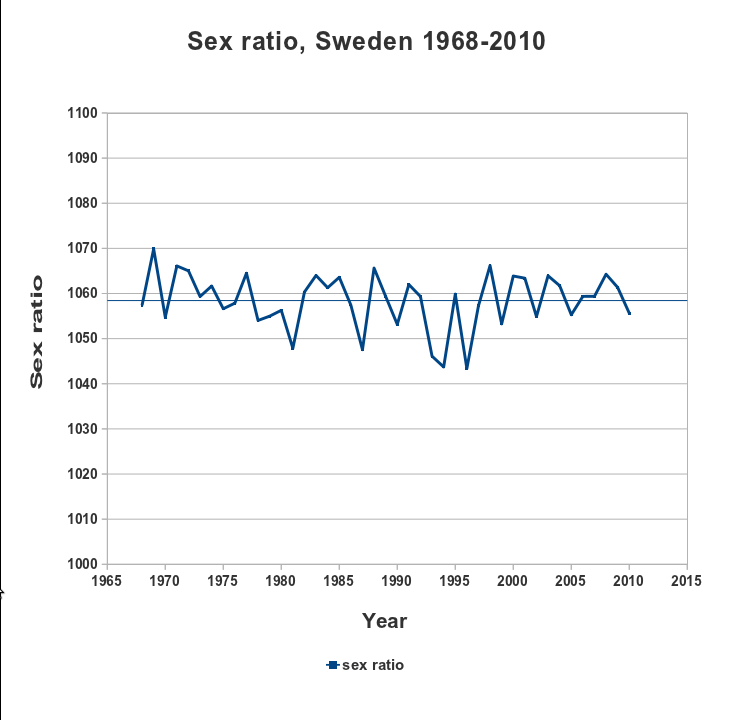
We see that the sex ratio is indeed very close to 1055, the average rate is 1058. And it fluctuates very little, it is always well within the span 1040-1070, with minor statistical deviations. But we have lots of statistics when we use the number of born children in entire Sweden. So let us look at the same situation for a medium sized city in Sweden, for instance Avesta, the city where I was born. We use a blue line for the sex ratio for each year, and a red line for the 5-year average:
- Annual sex ratios, and 5-year averages for the Swedish city Avesta (population 21507).
Interesting fluctuations indeed! Busby has made a lot of fuss about the level 860 boys to 1000 girls. This in a total cohort of 4843 persons. The population of Avesta is more than 21 000, so we should have more than enough statistics in order to make a fair comparison and even err on the side of caution. We see that the sex ratio (blue line) fluctuates year by year around the expected value of 1055 boys to 1000 girls, though in some years the sex ratio is down to 800 boys to 1000 girls. But in the Fallujah study the data were shown as cohorts of 5-year averages. The red line shows the data for 5-year averages for Avesta. This curve does not fluctuate so drastically as the blue line, the extreme values cancel out. In spite of this we see a drastic decrease in the sex ratio for the last five years, going down to slightly less than 900. This is not as low as the value 860 in Fallujah. But it is based on better statistics, and from a trustworthy source that probably has the numbers correct down to each individual child. And to my knowledge Avesta has not been bombarded with uranium based weapons recently.
Now, can we find any city in Sweden where the 5-year average of the sex ratio at some time in the period 1972-2010 is lower than 860? In order to be fair we should set a constraint that the city should not be too small. The population pyramid in Sweden is very different from the one in Iraq, so in order to have enough children born for a fair comparison we set, arbitrarily, that we want to find a city with a population of at least 10 000, where the 5-year average of the sex ratio at some time has been below 860. Well, look:
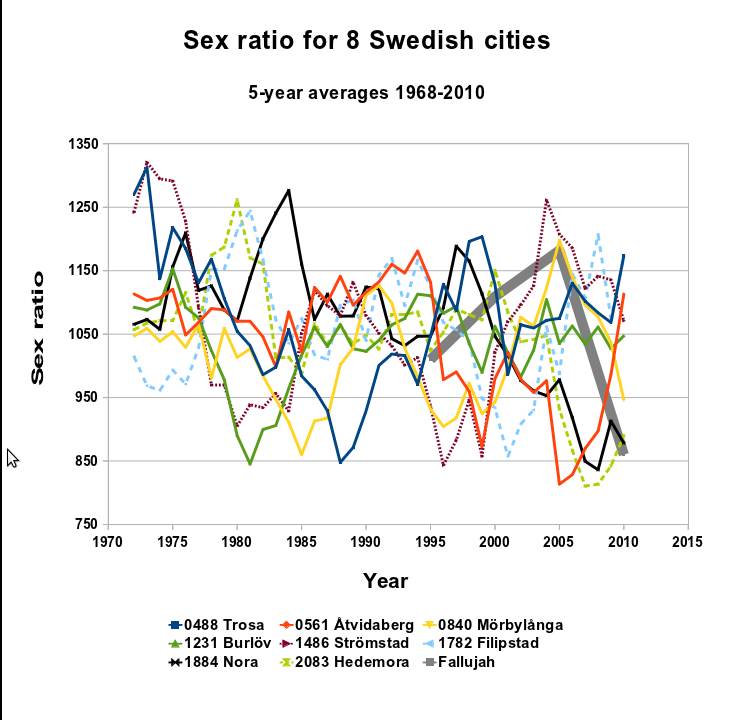
The figure is a bit messy, but the main point is to look at the extreme values for each city. We find eight cities that fulfill the requirement of a 5-year average sex ratio that at some time is below 860. The cities are: Trosa (pop 11 492), Åtvidaberg (11 474), Mörbylånga (14 152), Burlöv (16 825), Strömstad (11 965), Filipstad (10 506), Nora (10 462) and Hedemora (15 141). The data from Fallujah are shown as a broad grey line.
Wait a minute, you may say. These cities are probably from the same region, and share some common environmental effect. Hardly, the map below show their locations in Sweden. Furthermore, the fluctuations for the different cities do not agree in time with each other. It is therefore very unlikely to find a common cause. Except low statistics, just as in the sample from Fallujah. If we include Swedish cities with populations below 10 000 then we will find more than 30 with sex ratios below 860 in the 5-year average, some of them well below 750. The reason is, again, low statistics.

But what about the drastic decrease in the number of born children in Fallujah, the number of boys born went down with 50%? This must be due to an environmental effect, right? Well, not necessarily. There can be many different reasons for why there is a decrease in the number of born children, not the least after an intense battle occurring in the city. But let’s take a look at the 8 Swedish cities again, now we look at the number of born boys:
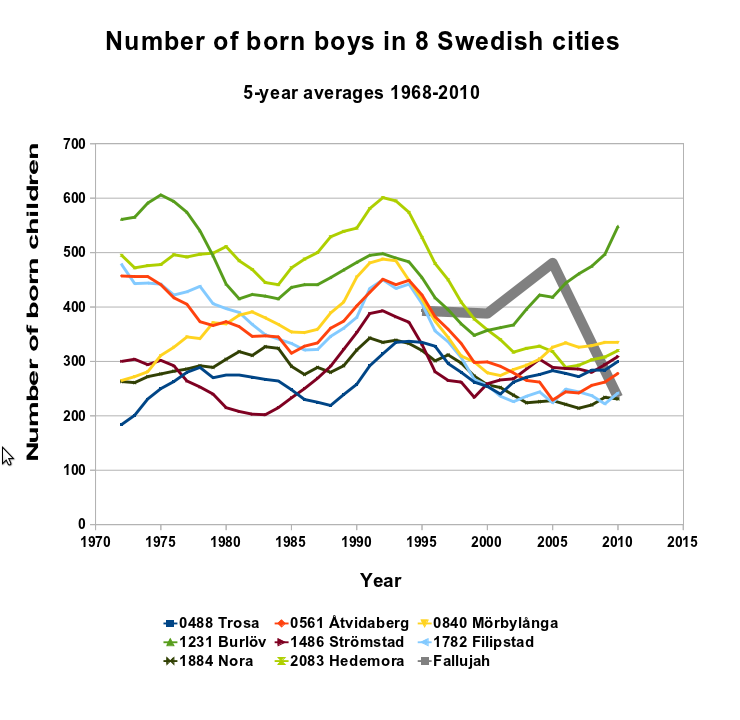
Once again we see that the dramatic variations in Fallujah are not extreme when comparing with some of the Swedish cities. Each Swedish city has its own behaviour, mostly depending on local variations in the population. But most of them share a common drop from a peak value around the year 1992. For Hedemora the number of born boys is reduced to almost 50% over a ten year period, with 35% decrease as the most dramatic drop over a 5-year period. But why is there such a decrease in most of the studied cities? Well, let’s look at the number of born children for all of Sweden:
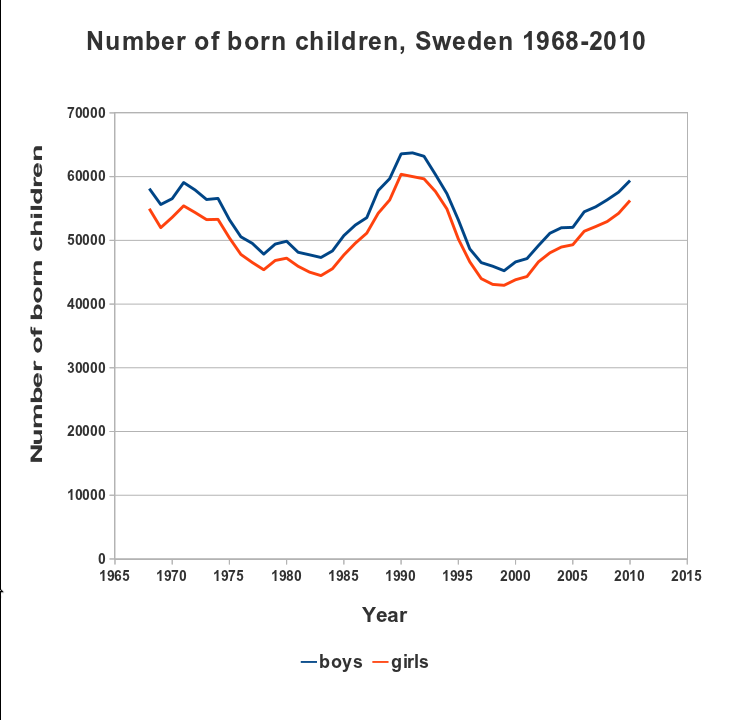
We see that there was a peak around 1992 followed by a quite drastic decrease, in 1997 the 5-year average number of born boys was 26% lower than in 1992. Is it due to the bad economy of Sweden at the time? Or was it less “popular” to have children for a couple of years? There are surely studies available regarding likely causes. Whatever the reason, we can easily exclude uranium based weapons. This does not disprove any hypothesis about uranium being the cause in Fallujah. Furthermore, I have only looked at the sex ratio while the article deals with a number of health effects, but whoever argues for uranium being the cause has a lot to explain before talking about significant findings the way Chris Busby does.
A few conclusions:
- All these cities have drastic variations in the sex ratio, even for the 5-year averages, and reach values lower than 860 boys to 1000 girls.
- For several of the cities the 5-year averages varies dramatically, similar to in Fallujah.
- The cities are distributed in different parts of Sweden with different geographical/environmental conditions.
- The periods of low sex ratio for the 8 cities occur at different times, no common cause can be seen.
- None of the 8 cities have suffered from war during the last 200 years, and during the last 40 years Sweden has been among the top ranked countries in the world when it comes to health status of the population.
- The variations are as large, or larger, than in Fallujah, based on much more reliable data, and equal or better statistics.
- Chris Busby should give up all attempts of epidemiology. This is not the first time he fails in this discipline, he just can’t do it right.
- We do not learn anything about the causes of the health effects in Fallujah by listening to self-proclaimed experts like Chris Busby.
There are indeed more things to say about Busby’s studies on Fallujah. When time permits they will be brought up on this blog.
Mattias Lantz – member of the independent network Nuclear Power Yes Please
Related blog posts:
Chris Busby and the Fallujah sex ratio – Part 1 (dishonesty)
Bad science – Chris Busby and his articles on Fallujah
3 Comments
The city of Fallujah in Iraq suffered through intense fighting during 2004, and US troops bombarded the city heavily. The US military has admitted to the use of white phosphorous, which is quite toxic though not necessarily cancerogenic. Whether depleted uranium (DU) weapons were used or not is still an open question, there is a number of statements in both directions from many different sources.
During the last few years there have been news reports about an alarming number of children born with deformities, and other serious health effects among the Fallujah population. In July 2010 a study by Chris Busby and coworkers was published in the International Journal on Environmental Research and Public health (here). The title of the article is the rather alarming Cancer, Infant Mortality and Birth Sex-Ratio in Fallujah, Iraq 2005–2009, and it reports on the results of a survey done in Fallujah that reveals drastic increases in various forms of cancer and birth defects.
The details of the study can be found directly in the paper (here), or from Busby’s presentation about it in Stockholm in August 2010 that is available on Youtube (here). A transcript of what he says in the presentation and the discussion after is given here.
There are many things that can be said about the survey and the quality of it. Considering the difficulties of performing the survey, and the limitations of this kind of survey (knocking on doors and asking about the health status of the people living there), one has to be very careful and consider all the weaknesses before drawing any conclusions. Busby and coworkers cover much of these concerns in section 2.3 of the article; Strength and Weaknesses. It says, among other things:
One weaknesses of this type of study is population leakage due to migration. Although ten years is used on the questionnaire, from analysis in earlier studies of this kind [7] it has become clear that there is leakage of cases (due to deaths and subsequent population movements) and so the recent five year period is employed.
In other words, if the survey gives the result that 100 people in a population of 1000 suffer from a certain disease, giving a rate of 10%, it means that the actual rate can be different due to the fact that some of the people suffering from the disease may have died or moved away before the survey was done. This makes sense, but then there is a strange passage:
However, as a consequence of such a population leakage it is clear that the result will show the minimum cancer rates existing in the study group. In earlier studies this effect was especially found for lung cancer which has a high mortality to incidence ratio.
This part is not so obvious. Of course, if the people who died or moved away suffered from the same disease, the rate would be higher if they had still been alive and had participated in the survey. But it could also be the opposite, the people who died or moved away did not suffer from the same disease, and if they were still alive and participated in the survey the rate would be lower. So, if the disease we are looking at has a high mortality rate, as in the case with lung cancer, then the assumption may be reasonable, depending on how many people that have moved away or died of other causes. Clear it is certainly not.
Another interesting thing is that, while Busby and co-authors in the article are very careful about not stating that uranium is the cause of the health effects, Busby has no qualms about laying out the words in other places. For instance, in the Green Audit report where he claimed that 10 tonnes of enriched uranium had leaked from the Hinkley Point nuclear power plant, he puts them together without further explanation:
Most recently, alarming increases in breast cancer, leukaemia, childhood cancer and congenital malformation/infant mortality increases were found in Fallujah, Iraq, a city where uranium weapons were employed and uranium particles will have been inhaled (Busby et al 2010).
So even though the original paper does not show any connection between uranium and the health effects, he makes it sound like there is an obvious connection when he refers to the paper in other works.
Well, let’s move on. In section 2.5 of the article the sex ratio is defined in one line as:
The population data in 5-year age groups was used to examine the sex ratio in 5-year birth cohorts.
In section 3, which covers the results of the survey, we read the following regarding the sex ratio:
The responses show that there is an anomalous sex ratio in the 0–4 age group. There are 860 males to 1000 females, a significant 18% reduction in the male births from the normal expected valueof 1,055 (267 boys expected, 234 observed; p < 0.01)
860 boys to 1000 girls after the 2004 battle, this does indeed sounds serious if the normal ratio is 1055. To use Busby’s own words from the BSRRW meeting:
“It is absolutely standard, and very rarely diverse at all, that number, unless there is some problem.”
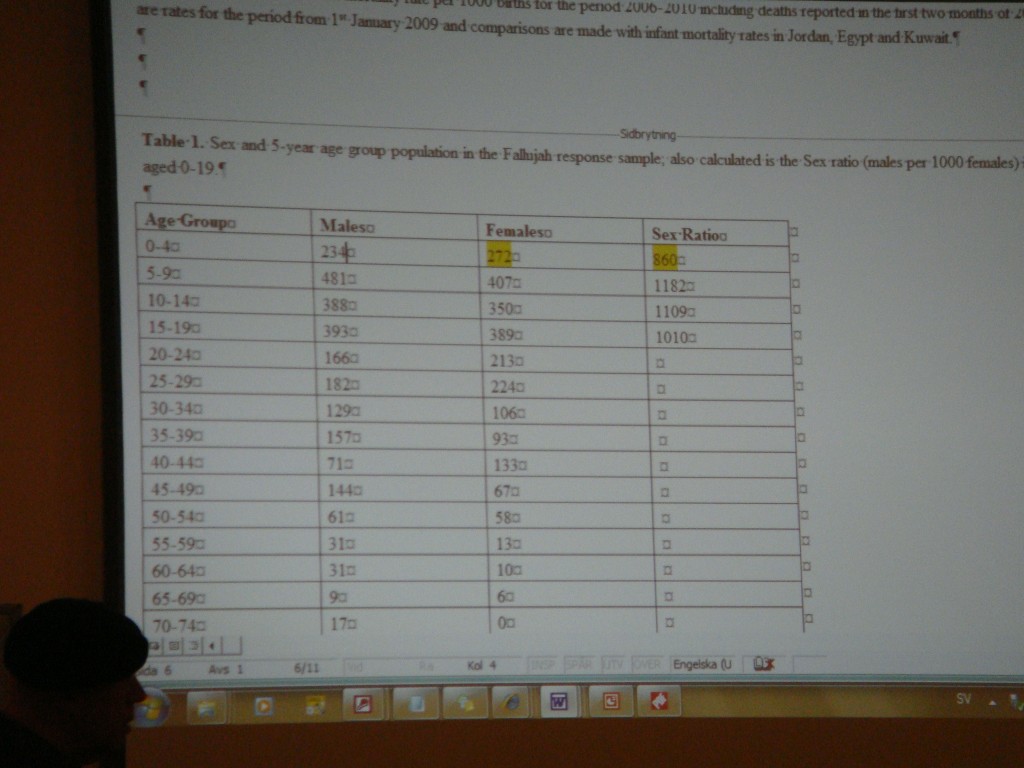
But what possible reasons could there be for it? Section 3 of the paper continues:
Perturbation of the sex ratio is a well known consequence of exposure of mutagenic stress and results from the sensitivity of the male sex chromosome complement to damage (the females have two X chromosomes whereas the males have only one).
So according to Busby and co-authors, mutagenic stress is the cause of why less boys than girls are born. The text continues with an explanation of what can cause mutagenic stress (emphasis is mine):
A number have studies have examined sex-ratio and radiation exposure of mothers and fathers. Of relevance is the study of Muller et al. [10] of the offspring of 716 exposed fathers who were Uranium miners. There was a significant reduction in the birth sex ratio (fewer boys). Lejeune et al. (1960) [11,12] examined the offspring of fathers who had been treated with pelvic irradiation; at high doses there was an increase in the sex-ratio, but this reversed in the low doses (around 200 mSv). Schull et al. 1966 [13] found a reduction in the sex ratio in A-Bomb survivor fathers (mothers “unexposed”) for children born 1956–1962 a reversal of an earlier finding by Schulland Neel 1958 [14] of a positive effect in the 1948–1955 births. It should be noted that there were external and internal irradiation effects in these groups, with the internal effects predominating in the later years. Yoshimoto et al. 1991 [15] found an overall reduction in the sex ratio for A-Bomb survivors for children born 1946–1984. Thus the evidence suggests that exposure to ionising radiation at low doses and specifically exposure to Uranium may cause a reduction in the sex ratio.
The quoted references deal with uranium miners, medical radiation treatment, and radiation from the Hiroshima bomb. So, exposure to radioactivity among the parents may cause mutagenic stress, which leads to a reduction in the number of boys born. At least there were scientific reports about it during the 1950’s and 1960’s, five of the six references are quite old. One would expect that such a world famous radiation expert as Chris Busby should be able to back his reasoning with references that covers the development of the field until present instead of what happened more than 45 years ago. There is nothing wrong with referring to old articles, but if you only do it and ignore later developments (if they exist) then your line of reasoning may be very weak.
Regarding the low sex ratio in the case of Fallujah, could there be other reasons than uranium-based weapons? Please note that Busby and co-authors do not mention any of the studies that show a connection between deviating sex ratio and exposure to chemicals, heavy metals, smoking and other environmental effects (see for instance the Wikipedia entry on sex ratio). Busby does not even acknowledge the chemical toxicity of uranium, instead it has to be the radioactivity of uranium, if it is the cause. The authors mention depleted uranium several times, but are very cautious about drawing any conclusion regarding what is the reason. That is a wise approach considering all the uncertainties related to a study like this, and the fact that there are a number of other possible causes.
It is less wise, however, to emphasize uranium as a likely cause, or to claim that the 18% reduction of the sex ratio is significant when you are not even sure about what you have measured. During the talk at the BSRRW meeting in Stockholm in August 2010, a person in the audience, Dr. Eckerman, wanted to have a clarification of what the data really showed. After some confusion it turned out to be that the sex ratio was not derived from the number of born children, but from the number of children available at the time of the survey.
So, to repeat the quote from Busby’s presentation again:
“It is absolutely standard, and very rarely diverse at all, that number, unless there is some problem.”
As it turned out during the BSRRW meeting, there was indeed a problem. Not only did Busby ignore the earlier so cautious approach when he claimed that the deviation was significant, he also based the sex ratio on the wrong assumptions about the group of children.

You may wonder what’s the big fuss about? Well, if the sex ratio is to be trusted it has to be derived from the number of born children in the study group. If you instead only have data on the number of living children at the time you make the survey, then you are missing the children who may have died or moved away. Busby disqualified the method himself when I asked about the age group 5-9 years old, which seem to deviate in sex ratio in the opposite direction, i.e. there are significantly (13%) more boys than expected. To be fair to Busby, for the age group 5-9 there are more children that may have died or moved away (or moved to the city) than for the age group 0-4 years, there have been 5 more years when things can happen. But even with that in mind, it is very irresponsible of Busby to claim that it is such a significant finding, when he ignores all the weak points in his reasoning.
So all the time Busby has known that the reported sex ratio is based not on the number of born children, but instead on the number of children available at the time of the survey. The message from Dr. Eckerman is quite clear; to speculate about the causes of the deviating sex ratio should not be done without keeping the limitations of the study in mind. And if you are honest in your approach, you make a clear statement about this the next time you present the study. In spite of this, when Busby a few weeks later has a presentation about his study at the Human Rights Council in Geneva (22 September 2010) he repeats the same thing without any caveats. In fact he says:
Then most important, we found the sex ratio… […] This is the most important result that we had here.
It seems as if he has forgotten Eckerman’s objections. To be fair, he does say that there are some structural problems with the study, and that those concerns are brought up in the paper. But he gives no details about these structural problems during the talk. Instead he goes on with all sorts of explanations about the causes (including some ludicrous speculation about cold fusion based weapons!), as if they were clearly established facts. A year later all concerns about weaknesses in the study seem to be forgotten. The new article about Fallujah (Alaani et al., Conflict and Health 5:15 (2011)) starts off with the following statement in the second sentence (emphasis is mine):
In addition to the increased cancer and rates and infant deaths, the epidemiological study [1] showed that there was a sudden significant drop in the sex ratio (an indicator of genetic stress) in the cohort born in 2005, one year after the battles which occurred in the city, suggesting that the cause of all these effectsis related to the time of the US led invasion of the city in 2004.
I could buy the argument if it was phrased something like “the epidemiological study [1] gave an indication, although with large uncertainties, of a reduction in the sex ratio…” But as we have seen before it is not in the interest of Chris Busby to be clear about the details, at least not when the details make the case weaker. Instead he never misses a chance to bring it up, for instance in the RT interview from 26 October:
http://rt.com/news/uranium-birth-defects-fallujah-729/
or in the LLRC press release:
http://llrc.org/du/subtopic/fallujah20oct2011.htm
Busby has to push the line that there has been a significant change in the sex ratio, and without stating it clearly he and his co-authors do everything but saying it straight out that it must be due to uranium.
So we now have seen how Busby in writing is very careful with stating too clearly that there is a clear connection between the deviating sex ratio and some sort of uranium based weapons. In talks and interviews however, he clearly gives a different message. And he consistently ignores all other possible explanations, just as if they wouldn’t even exist.
Now the question is, is the deviating sex ratio in Fallujah even relevant? We will look at this issue in part 2. Stay tuned.
Mattias Lantz – member of the independent network Nuclear Power Yes Please
Related blog posts:
Chris Busby and the Fallujah sex ratio – Part 2 (incompetence)
Bad science – Chris Busby and his articles on Fallujah
7 Comments
A few weeks ago there were some absurd information posted on the BSRRW web site, portraying our favourite alarmist Chris Busby (who recently turned into a quack) in some sort of road movie. In this movie he is accompanied by Ditta Rietuma, member of the supporter club BSRRW, as well as the Baltic Sea Regional Office of the ECRR (sounds fancy, doesn’t it?). First they go to Socialstyrelsen (The Swedish National Board of Health and Welfare) in order to request data from the cancer registry for the purpose of investigating cancer rates after Chernobyl, with the supposed increased effect from the Baltic Sea (the world’s most radioactive sea, as they call it).
The information is on the main page of the BSRRW web site, but here is a direct link to the Youtube film in case that the other link changes.
Below is a transcript of what Busby says before entering Socialstyrelsen:
Here we are. Ok I’m standing outside the Socialstyrelsen in Stockholm. This is the social welfare place that involves itself with human health, and the director, the medical director of this outfit is Lars-Erik Holm who is the ex-director of the International Commission on Radiological Protection. So this is a little like putting Genghin Khan in charge of something. Because this guy, Lars-Erik Holm, believes that radiation is safe and can’t harm you, and he says that the outcome of the Chernobyl accident is that there were just a few thyroid cancers and that’s it.
So we’re going in now to talk to some apparatchik here, trying to get data on cancer. Because of course the Baltic Sea is very radioactive and we want to see if it’s having any effect on the people who are living on the shores of the Baltic Sea. So, we’re going to try to get the data, but of course so far they’ve said that they’re not going to give us the data.
So we’re going to see what kind of data that we can get, and put a little bit of pressure on them, you know, about this matter, which is really essentially a question about human rights. Because after all if you have a country and you have a government and you have a Socialstyrelsen, that are supposed to look after the people, but actually allows the north to die of cancer because the director of the outfit happens to be a nuclear industry stooge from way back. Then this is a matter of human rights, and at some point it has to go to court.
Some statement indeed, sounds pretty serious. And it is quite some claim that the director of Socialstyrelsen is payed by the nuclear industry to allow people in northern Sweden to die from cancer. Typical scaremongering from a scaremonger, but hardly a typical behaviour from a person who claims to be professor and scientist (and makes a big deal about others who are not).
Busby leaves Socialstyrelsen after having been denied the data. The second part of the road movie (here) shows Busby and Rietuma, on a motorcycle, delivering a letter of complaint to the Chancellor of Justice, with the title “Human Rights and Environmental Protection Laws addressing the issue of the most radioactive sea in the world – The Baltic Sea.”
The letter of complaint is signed by the following notable persons:
- Chris Busby — Scientific secretary of the ECRR
- Ditta Rietuma — General secretary of the Baltic Sea Regional office, ECRR
- Roland von Malmborg — Chairman of the Baltic Sea Regional Radioactivity Watch NGO
- Åke Sundström — Board of the International Foundation for Research on Radioactivity Risk
- Olle Johansson — ECRR group at the Karolinska Institute
The signatories reveal some interesting information regarding their supporter clubs. For instance we find that Karolinska Institutet, who awards the Nobel Price in Physiology or Medicine, has an ECRR group. Are there more members than Olle Johansson at KI? It is at least a relief to see that he is not a member of the Nobel Assembly (here). Then we find a connection between Åke Sundström and the mysterious IFRRR web site which sponsors some of the ECRR work. Good to know that it isn’t some Russian gas company behind it, there are enough conspiracy theories floating around as it is.
The complaint starts with referring to various declarations and resolutions from the United Nations and other organisations regarding people’s fundamental rights of good health and environment. In summary, they state that the public authorities in each country should protect the environment of its population and give adequate information about the environment and related health risks. If this is not done, they should be taken to national court, and if such a court process is not given, the matter is to be taken to the international court. Sounds pretty reasonable to me, if you have a valid claim.
After this introduction the main part of the complaint starts:
“Now therefore we refer to the matter of: Widespread radioactive pollution of the Baltic Sea and Baltic Sea coasts and projects involving further such contamination:”
Hm, we have heard these claims before, haven’t we? They were not valid then, are they now? Let’s return to that issue later on, now we continue with the letter of complaint. There are 7 points being made:
- 1. Much information on the radioactivity of the Baltic Sea region is missing. Whilst some information on the current levels of environmental contamination is available in scientific literature, the public is left uninformed. Missing is even the interpretation in terms of effects of environmental contamination on public health (see below). The issue is not properly discussed, nor is it open to such discussion by those citizens affected by environmental degradation. Huge efforts are made to limit pollution from cigarette smoke even though the evidence of ill health from passive smoking is weaker than the evidence of ill health due to radioactive contamination following Chernobyl effects in Sweden (Martin Tondel et al., 2004)
Missing information? Well, the HELCOM documentation is out there for anybody to read. And for those who have the patience to read the full report on radioactivity in the Baltic Sea, rather than BSRRW’s cherry picked extract, it is clear that the radioactivity is of some concern but hardly the most urgent environmental matter for the Baltic Sea. If Busby and his supporter gang really cared about bringing the information out to the public they could do much better than spreading the misinformation that nuclear power plants are the main source of the radioactivity in the Baltic Sea. For the record, there is a contribution of radioactivity to the Baltic Sea from the running plants, but it is only about 0.04% of the total amount, more than 80% comes from the Chernobyl accident. And besides a number of hot spots in the bottom sediments, which admittedly are of some concern, the levels of radioactivity in the sea water, and in fish, are not near any values where health effects can be suspected. Furthermore, the total amount of man-made radioactivity in the Baltic Sea amounts to about 30% of the natural levels. This is information that you will not find if you choose to listen to Busby and BSRRW (credit to the anti-nuclear group MILKAS for keeping the presentation by Sven P. Nielsen on their web site).
The claim about weak evidence for ill effects due to passive smoking is quite remarkable. There have been some controversy on the issue, but mainly due to studies sponsored by the tobacco industry. So it is interesting to see that Busby and his gang choose to disregard most of the scientific studies on the issue (see for instance the Wikipedia page on passive smoking) and prefers to side with the tobacco industry. All this in order to try to make the point that the evidence for health effects in Sweden after the Chernobyl accident are better established.
So what are the evidence? There are, to my knowledge, only two studies regarding health effects due to Chernobyl in Sweden:
- The first is the highly criticized PhD thesis by Tondel. Besides the fact that the opponent more or less cut it into pieces, it had the extraordinary feature that the PhD thesis jury gave a statement that they did not agree with any of the conclusions drawn in the thesis, but that they let it pass because the defendant had fulfilled the formal provisions for a PhD thesis (analysis work, publications in peer review, etc.). Here are a few links about the debate that followed in the Swedish medical doctor’s magazine Läkartidningen: Holm et al., and Tondel et al’s response. Oh, by the way, some people might find it to be of interest that one of Tondel’s supervisors is Lennart Hardell.
- The second is Chris Busby’s attempt to scare the population around the Baltic Sea with data from Socialstyrelsen’s cancer statistics data base (available to the public here), where he claimed an increase in breast cancer in counties bordering the Baltic Sea, while there was no increase in inland counties. It turned out to be a very lousy attempt of cherry-picking, where he (1) disregards the data that falsifies his theory, (2) does not correct for the general linear increase of breast cancer that is evident in the data from 1970 and on, (3) ignores the fact that breast cancer screening was introduced in some of the counties during the time period, giving a temporal increase in the incidence rates, and (4) makes an alarmistic press statement about his so called research findings. Below is a picture showing the data used by Busby, but I have added the counties that he did not include. More information is given in my report from the BSRRW meeting in Stockholm, August 2010 (here).
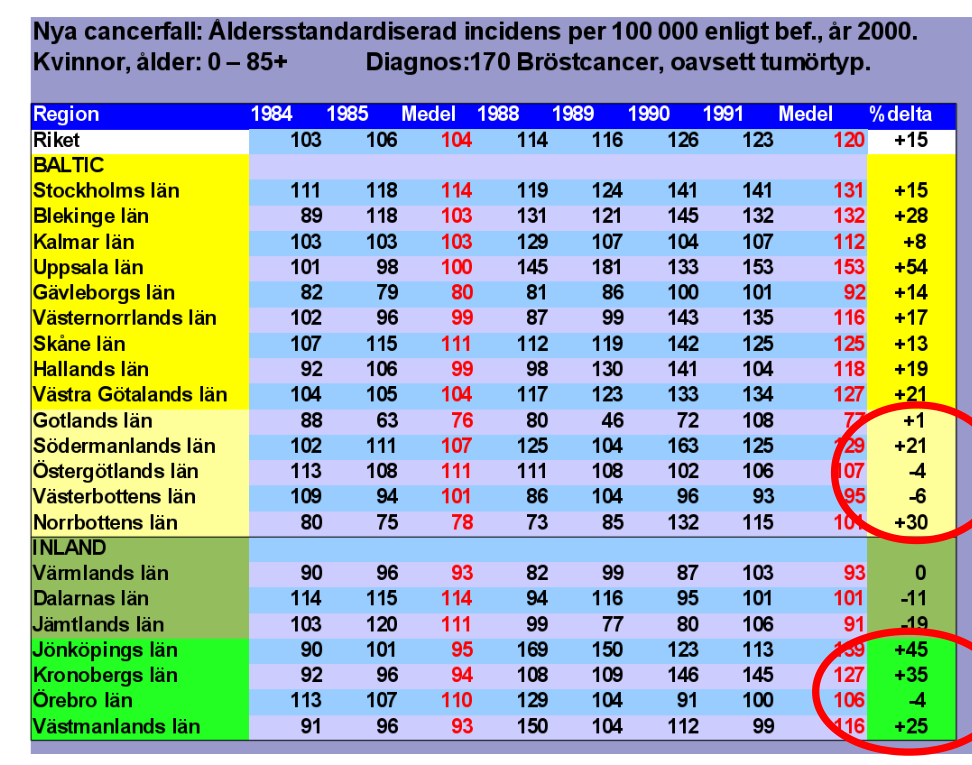
So to claim that there are good evidence for “ill health due to radioactive contamination following Chernobyl effects in Sweden” is a bit…wrong.
And if they really think that the public is left uninformed about some issues (the real ones that is, not the fake ones made up by Busby), why not write to the public opinion pages on newspapers and bring it up for public debate, rather than starting off with writing complaints to the Chancellor of Justice?
- 2. Such discussion and consultation is essential to inform on the potential harm of this contamination.
Sure, we need to discuss the environmental status along the Baltic Sea, and possible health effects. Once we have dealt with the high levels of dioxine, the PCBs, the eutrophication, the over fishing, the annual problems with the algea, and the occasional oil spills, then we can start asking ourselves if the radioactivity in the Baltic Sea is something to worry about, i.e. if there is something that the HELCOM studies have missed. But the radioactivity in the sea is not an issue just because a certain self-proclaimed expert and his fan club happens to say so. It could be worth listening to if he had had a serious approach to the issue. Instead he cheated (or was extremely careless in how he handled the data, very remarkable for a person who claims to be professor and scientist) with publicly available data and made an alarmistic press statement about his conclusions. So we can happily have a discussion about the Baltic Sea and its environmental status. But will we learn anything by inviting Chris Busby and the BSRRW supporter club to the meeting? I seriously doubt it. The link below is an example of where BSRRW clearly shows that they, at best, would be a comical side show:
http://www.bsrrw.org/?page_id=89
They refer to a study by SKB and the Risö Laboratory where uranium contents in the ground, in sea water, and in plants, have been measured near the Forsmark nuclear plant. After the link to the report comes a very funny comment: “BSRRW: The conclusion that Uranium isotopes around Forsmark NPP do not exceed the natural backgound radiation are based on the wrong ICRP model.” Yep. They actually state that there is something wrong with the measurements because of Busby’s claims about the ICRP model being corrupt when it comes to radiation risk. In other words, they refer to Busby’s claims but clearly show that they have no clue about what it is that he is saying. Some supporter club indeed, or should we say sect?
- 3. Many informational aspects of the contamination levels are not available or have not been obtained through measurements, e.g. (i) sea to land transfer of radionuclide particles and inhalation in coastal environments (ii) concentration of uranium particulates in coastal environments.
Besides once again ignoring all the work through HELCOM, and the SKB/Risö study mentioned above, this is just another shameless attempt to push forward Busby’s cherished idea about a coastal effect. He claims that there is an effect, again on a very loose foundation. When we looked into his claims about Hinkley Point we found that he tried to fit a curve to data that were clearly from a random distribution in order to claim that this effect is real. In the present case we should credit Busby for not referring to any of his earlier claims, it is just words, words, words.
The second point about uranium particulates is a bit ridiculous, not the least when considering the SKB/Risö study mentioned above. Furthermore, Busby and his gang could start with the exercise of estimating how much uranium that is brought into the Baltic Sea every year from the Swedish rivers, they will probably be surprised.
- 4. Private industry continuing contamination of the Baltic (e.g. Studsvik, Fortum, E.ON, Vattenfall, etc) has not been properly made subject to any of the procedures on public participation in decision-making.
No public participation? I don’t know what they are smoking in this case, but if it is not ignorance then it is a lie. The nuclear industry (and some other industries as well) repeatedly has meetings with locals on various issues, including environmental effects (so called “samråd”). There is a continuous process of informing local stakeholders on these issues, and the stakeholders can make their voices heard. This does not mean that the opinions of the local stakeholders will be followed, but they get the chance to get heard, and may appeal to higher instances if they feel that their rights have been sidestepped. Besides that, all the activities are regulated through laws and regulations in order to protect the interests of the people. It is up to goverment authorities, such as the Swedish Radiation Safety Authority (Strålsäkerhetsmyndigheten) to inspect that these issues are properly handled by the industry. And in case that somebody has missed it, these government authorities are implementing the policies and laws that have been decided in the parliament of Sweden, which since 1921 is a representative democracy with universal suffrage. We can forgive Busby for not being aware of it, but maybe the supporter club could have briefed him on it before they embarked on this ridiculous path?
- 5. Methodology for assessing the effects of such environmental contamination is suspect and has not been opened for discussion e.g. the International Commission on Radiological Protection (ICRP) vs. the European Committee on Radiation Risk (ECRR) (1). The Swedish national competent authority SSM (Strålsäkerhetsmyndigheten) is criminally highly irresponsible in that it has not incorporated developments in radiation risk assessment and many recent post-Chernobyl studies which show clearly that its current methodology is unsafe for radiological protection of the public.
I fail to see that Chris Busby’s methods shown so far are any less suspect. SSM is “highly criminally irresponsible”, wow! And their crime turns out to be: they prefer to trust the main scientific knowledge about radiation effects instead of believing in Busby and his methods. Well, put me on the same stand when it is time for the trial.
- 6. Regarding the question of disputed methodology for radiation risk assessment it is a matter of serious conflict of interest that the Medical Officer of Health for Sweden, the head of Socialstyrelsen, is Lars-Erik Holm who was previously head of SSM (previously SSI) and also President of ICRP whose risk model is used to inform risk from such radiation exposure. This is similar to the recent conflict of interest scandal of professor Anders Ahlbom at the Karolinska Institute and mobile phone radiation safety [cf. http://www.monanilsson.se/document/AhlbomConflictsIARCMay23.pdf].
Hm, maybe they should investigate Holm’s job description before they start complaining about it. And once again it would be nice if the supporter club briefed Busby on how the Swedish authorities work, if they know that is. From what we see in the letter of complaint, and what Busby says in the road movie, they are probably convinced of that Lars-Erik Holm is personally deciding on who will get access to the data base.
Besides the fact that Busby has shown himself incapable of not mistreating public data, the road movie gives no hint that he has done anything more than stepping in to Socialstyrelsen with the demand: “I want your data on cancer!” If he had a valid claim in the letter of complaint he would show that he was denied the data after having submitted a well thought out research plan where he intends to investigate blah blah blah, motivated by earlier studies by blah blah blah on blah blah blah, and he intends to perform the research in the following manner, publishing the results in journals such as blah blah blah. Such an application, together with the written refusal from Socialstyrelsen, would be included in the letter of complaint. We have no hint of any of this, all we get is blah blah blah. Some scientist he is, and some supporter club he has, there are motorcycle gangs that behave better than this.
- 7. Small area cancer and other disease incidence data which would inform on these issues is seen as information on the environment and should be subject to the above human rights declarations yet is kept confidential by Socialstyrelsen and Statistiska Centralbyrån in Sweden.
This is an interesting issue. Personally I would prefer if public health data were publically available to a larger extent than what it is today. The reasons for restricting them is mainly due to privacy issues (and to avoid that every self-proclaimed expert makes a lot of fuss by interpreting data in ways that they are clearly not competent to do?). So, what stance to take on the fact that Socialstyrelsen denied Busby access to the detailed data? Considering that he last year used the part of the data that are publically available, and managed to fail big time with handling them in a responsible way, there is no reason to believe that he would manage to handle more detailed data any better. Until he learns how to handle the public data properly, and without making an alarmistic press statement about his findings (whatever they may be), there is no reason for Socialstyrelsen to give him anything. Furthermore, if he has not even requested the data according to the formal procedures, then there are certainly no reasons to sympathize with him and his complaint to the Chancellor of Justice. But we can condemn him for making such a fuss about nothing, and pity him for having such worthless advice from the local fan club on how to deal with government authorities in Sweden.
In some sense, by denying Busby the data, they treat him like a child who needs to learn some manners before being trusted with the good stuff. Chris Busby is 66 years old, so treating him like a child may sound a bit ridiculous. On the other hand, when Socialstyrelsen isn’t giving him the candy that he wants, he goes whining to the Chancellor of Justice, threatening to bring the case to international court. Grow up, kid!
Mattias Lantz – member of the independent network Nuclear Power Yes Please
P.S. For those who didn’t like the road movie above, here is the original. Enjoy the song and the scenery. Just remember to exchange the word “room” for “cancer statistics” in the end and we probably have a fairly good account of the conversation between Chris Busby and the staff at Socialstyrelsen.
6 Comments


